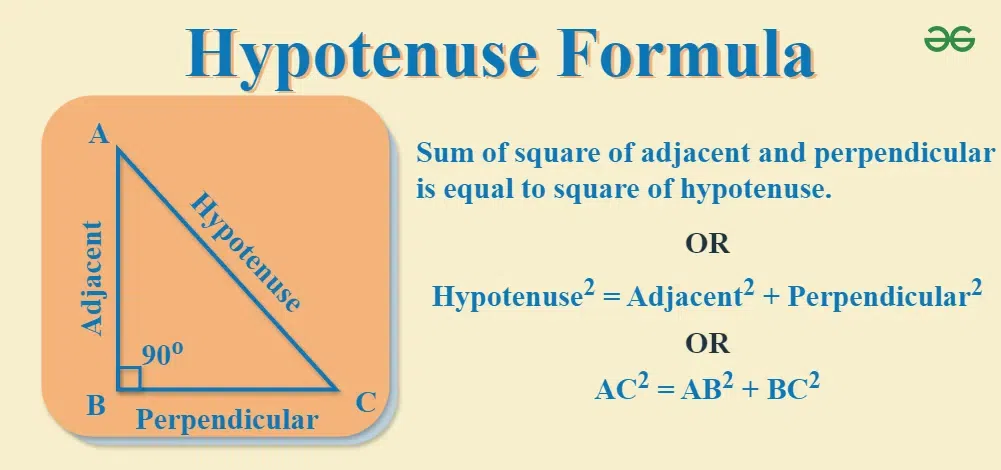
|
|
Hypotenuse Formula or Hypotenuse Theorem Formula is another name for Pythagoras Theorem. Hypotenuse Formula is used to calculate the third side of the right-angled triangle given the other two sides. Hypotenuse Formula can be defined as a relation among the three sides (hypotenuse, base, perpendicular) of a right-angled triangle. Hypotenuse Formula states that the sum of squares of two small sides(base and perpendicular) is equal to the square of the longest side (hypotenuse). In this article, we will explore all the basic details of the Hypotenuse Formula, including the mathematical expression, proof, and various solved examples using the Hypotenuse Formula.
Table of Content What is the Hypotenuse?In a right angle triangle the one which is just one that falls opposite to 90 degrees is the Hypotenuse. The Hypotenuse is always the longest side of a right triangle. Furthermore, in a right triangle, the square of the length of the Hypotenuse is equal to the sum of the squares of the other two sides. The term hypotenuse occurred from the Ancient Greek word hypotenuse, which means ‘extending under a right angle’. The Hypotenuse will always be the longest side in a right triangle since it is opposite of the largest angle, the 90 degrees angle Hypotenuse Formula in TriangleBy using Pythagoras Theorem Formula, we can calculate Hypotenuse Theorem Formula
Here, c is denoting the length of the hypotenuse and a and b are denoting the lengths of the perpendicular and the base. Pythagorean TheoremPythagorean theorem also known as Pythagoras’ theorem can be defined as a relation among the three sides (hypotenuse, base, perpendicular) of a right-angled triangle. It states that the sum of squares of two small sides(base and perpendicular) is equal to the square of the longest side (hypotenuse). This theorem is named after the Greek philosopher Pythagoras who was born around 570 BC.
Hypotenuse Formula ProofAs Pythagorean theorem shows the relation in the sides of a right-angled triangle, so if the length of any side is missing, it can be calculated using the Pythagorean Theorem. In a right triangle ABC, right-angled at B. To Prove: Hypotenuse2 = Base2 + Perpendicular2
In the below triangle ABC, let us draw a line from B to touch the side AC at angle D. By similar triangles theorem, we can write the following equations such that, △ADB ~ △ABC So we can write equation as ⇒ AD/AB = AB/AC ⇒ AB2= AD × AC . . .(i) Again, △BDC ~△ABC So, we can write equation as follows ⇒ CD/BC = BC/AC ⇒ BC2 = CD × AC . . .(ii) Now, if we add (i) and (ii) we get; AB2 + BC2 = (AD × AC) + (CD × AC) Taking AC as common term from right side, we get; ⇒ AB2 + BC2 = AC × (AD + CD) ⇒ AB2 + BC2 = AC × (AC) ⇒ AB2 + BC2 = AC2 Hypotenuse2 = Base2+ Perpendicular2 Hypotenuse = √ (Perpendicular²+ Base²)
Application of Hypotenuse FormulaThere are many real-life application of Hypotenuse Theorem can be seen in day-to-day life and in various fields. Below are some of the applications:
How To Find Hypotenuse of a Right Angle TriangleTo find the Length of Hypotenuse in a right triangle, the square of the length of the hypotenuse (the side opposite the right angle) is equal to square root of the sum of the squares of the lengths of the other two sides. The formula to find length of the hypotenuse is:
How To Find the Unknown Side of Right TriangleTo find the unknown side of right angled triangle: If we need to find a, as a is the unknown side, then transform the hypotenuse equation to the form where a is on one side and take a square root:
If we need to find b, as b is the unknown side, then transform the equation to the form where a is on one side and take a square root:
For hypotenuse c is missing and we need to find c, the formula to calculate hypotenuse c side is:
Read More, Hypotenuse Formula in Real-LifeHypotenuse has many application in real life. We use hypotenuse formula in many situations like:
Sample Problems on Hypotenuse FormulaProblem 1: Find the hypotenuse of a right angled triangle whose base is 6 cm and whose height is 8 cm? Solution:
Problem 2: Find the base of a right angled triangle whose hypotenuse is 13 cm and whose height is 12 cm? Solution:
Problem 3: Find the perpendicular of a right angled triangle whose hypotenuse is 25 cm and whose base is 7 cm? Solution:
Practice Problems on Hypotenuse FormulaProblem 1: Find the length of the Hypotenuse of a right triangle of which the other two sides measures 7 cm and 15cm? Problem 2: Find the perpendicular of a right angled triangle whose hypotenuse is 30 cm and whose base is 7 cm? Problem 3: The hypotenuse of a right angled triangle is 6 units. Its base is 2 units. Find its height using the hypotenuse formula? Problem 4: Find the base of a right angled triangle whose hypotenuse is 15 cm and whose height is 12 cm? Problem 5: Find the length of the Hypotenuse of a right triangle of which the other two sides measures 6 cm and 12cm? Hypotenuse Formula: FAQsWhat is the Pythagorean Theorem?
How is the Hypotenuse Formula used?
What are the Sides a, b, and c in the Hypotenuse Formula?
Can the Hypotenuse Formula be used for Non-Right-Angled Triangles?
Can the Hypotenuse Formula be Rearranged to Solve for a or b?
Are there Other Methods to find the Length of the Hypotenuse?
What units should be used for the sides and hypotenuse?
Can the Hypotenuse Formula be applied to any Unit of Measurement?
Can the Hypotenuse Formula be used for any Shape?
|
Reffered: https://www.geeksforgeeks.org
| Class 8 |
Type: | Geek |
Category: | Coding |
Sub Category: | Tutorial |
Uploaded by: | Admin |
Views: | 14 |
